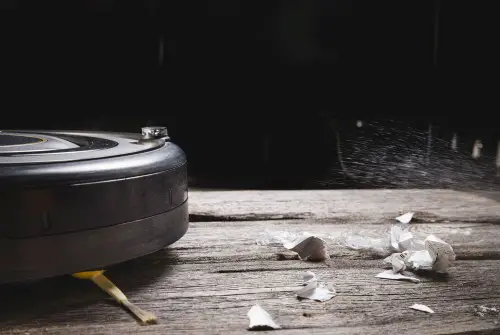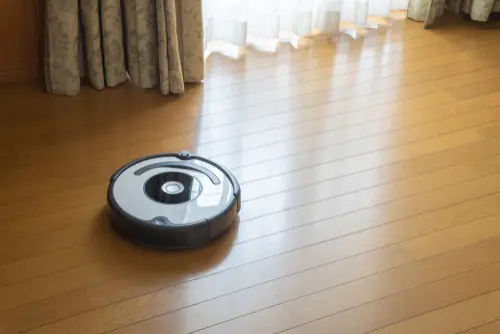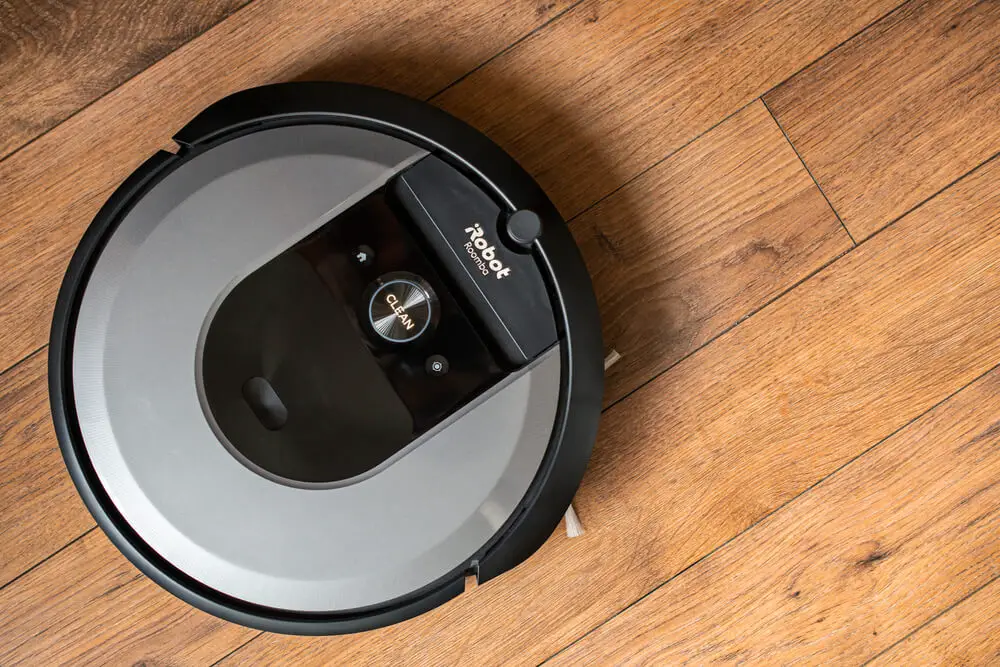iRobot's robot vacuums are quite popular due to their smart features and convenience for automated home cleanups. A common concern among those with multiple-story homes is whether this iRobot can effectively handle the different stories and sufficiently meet their cleanup needs.
Several Roombas, including the i6, i7, i7+, i8+, s9, S9+, and the latest addition, Roomba j7+, can map and clean more than one floor in your home. We've looked into each Roomba robot vacuum to help determine if it can deal with multiple-story houses. Our findings are listed below, so keep reading to learn more!
More...
Understanding Roomba Multiple Floors
Roomba vacuums are highly versatile and designed to adapt and clean multiple floors. However, it is essential to note that Roombas cannot climb or descend stairs, so they must be manually carried from one floor to another. To use a Roomba on various house stories, here's what to do:
Carry your Roomba to the desired spot and place it.
Press the Clean button on the vacuum.
Let your it run and map out the new floor using its sensors.
If you plan on using one Roomba for two floors in a house or more, it is wise to have two home bases or at least one base on each story. However, the staircase will be an issue, as you will have to manually carry Roomba's little robot from one story to the other. More on that in the next sections!
Cheap Roomba can Clean Multiple Floors (For Example - Roomba 694)
- Design: Sleek, premium design complements your...
- Auto-Adjust Cleaning Head: Auto-Adjust Cleaning...
- Adaptive Navigation: A full suite of advanced...
- Clean Floors Every Day: The Roomba 694 provides a...
- Automatically Recharges: The Robot Vacuum runs for...
Important Features for Multi-Floor Cleaning
Roomba's robots are becoming more advanced with each new addition to the line. For example, from Roomba's i7 to Roomba's new j7, the robots have an Imprint Smart Mapping feature that allows them to do a mapping run on various places or stories. The robot can store up to 10 plans, making it perfect for people with larger homes.
Another thing to consider is whether you will carry the charging station around with the robot. If you don't want to do that, you can always purchase two or more home bases and put them on different stories or areas around your home.
In addition to these primary features, there are some essential aspects to consider when using your Roomba on various house stories. To enhance the efficiency of your Roomba, it is essential to prepare each floor before the cleanup. Remove obstacles and close areas you do not want the Roomba to access. That will help your Roomba easily navigate your home and ensure thorough cleaning cycles each time it leaves its dock.
Yet another fantastic feature of the Roomba is its ability to adjust its cleanup settings automatically. Moving your Roomba from story to story will cause it to adapt to the specific surface it is cleaning, whether it's carpet, hardwood, or tile, further optimizing the cleanup.
Methods to Handle Multiple Floors

To use a Roomba on multiple floors effectively, consider the model and its features. If you have the i6, i7, i7+, i8+, s9, and S9+ models, and the newest j7+ model, you can let the Roomba map multiple floors. This feature enables these Roombas to navigate and clean various areas seamlessly.
Floor Mapping: If supported, use the "Start Mapping" feature on your Roomba to remember the house plans and quickly adjust to various areas.
Transporting the Roomba: The Roomba can move on its own only on a single floor. That means if you want another area or floor cleaned, you must manually move it and its home base to the area.
Cleaning Base Location: For Roombas with automatic emptying, like the i7+ and s9+, ensure there is a home base accessible on every floor. The Roomba will automatically return to this home base when it needs to empty its bin or recharge. If you have only one clean base but multiple stories on which you want to use the Roomba, consider getting a second home base.
Maintenance: Regularly inspect your Roomba for wear and tear, especially when cleaning multiple floors and various types of flooring daily. Check the brushes, filters, and wheels for damage or excessive dirt buildup. Make sure to clean and replace them when necessary.
Boundary Settings: If your Roomba model is compatible with virtual walls or no-go lines, use the iRobot app to set up boundaries to prevent the device from entering undesired areas. That can help preserve the Roomba battery but keep it going as much as needed.
Challenges with Roomba on Multiple Floors
Roomba robot vacuums are excellent for maintaining cleanliness across multi-story homes. It can remember the entire floor plan for each floor in your home. However, some challenges may arise when using Roombas for this purpose.
First, not all Roombas can do a mapping run and clean multiple floors. The good news is that some newer models, such as the i7, i8, s9, and j7, are equipped with Imprint Smart Mapping technology, which allows them to create and store up to 10 unique floor plan maps, making it easier to use the Roomba on in multiple places.
Another issue to consider is recharging the Roomba between cleaning sessions. You can always set a second home base, but purchasing it could be expensive, especially if the user wants an auto-empty base. To optimize Roomba usage, it's essential to strategically place the home bases on various floors and ensure the robot vacuum can efficiently find its way back to the charging station.
Wi-Fi coverage is a factor not to be overlooked when using Roomba on multiple floors. Roombas that use WiFi to map may face signal strength issues when transitioning from the first to the second floor and vice versa. To help maintain consistent WiFi coverage, users should ensure that their home WiFi setup provides a strong signal on each floor.
Lastly, it's important to remember that even though Roombas can handle multiple floors, regular maintenance and troubleshooting are crucial to keep the device running smoothly. Users should periodically clean the robot vacuum and be aware of the light ring signals to resolve any errors that may arise during operation.
Tips for Efficient Roomba Use on Multiple Floors

Using a Roomba on multiple floors can effectively and conveniently maintain a clean home with minimal effort. However, a few tips exist to optimize its efficiency on more than one floor:
Firstly, prepare each floor for the Roomba by removing obstacles such as cords, small toys, or other items that could hinder its movement. That will ensure a smoother cleaning process and prevent the Roomba from getting stuck or malfunctioning due to obstructions.
Secondly, consider using more than one home base for your Roomba to ensure it is fully charged between cleanups. By placing a home base on each level, Roomba can recharge as needed and seamlessly continue the cleaning process. Remember that Roomba charging stations can be expensive, so factor that into your budget as required.
When using the Roomba on different floor types, such as hardwood, carpet, or tile, it's essential to let the Roomba adapt to the surface before proceeding. Providing ample time for the device to adjust to each floor type will ensure a more thorough and efficient cleanup, minimizing the need for additional manual vacuuming or dusting.
Lastly, ensure proper WiFi coverage on all floors. Strong and consistent WiFi signals across all levels of your home will enable the Roomba to function optimally, especially in models with mapping capabilities. A stable connection helps the device better navigate multiple floors, resulting in a more efficient cleaning experience.
Comparison of Roomba Models for Multi-Floor Use
The iRobot Roomba vacuum cleaners are designed to be highly versatile and efficient. This article will compare some popular models of this iRobot device and discuss their ability to handle multi-story use.
i6, i7, and i7+ Models: The Roomba i6, i7, and i7+ models have a multi-floor map feature, enabling them to navigate and clean multiple rooms across different house stories. These models use advanced sensors to create a map for each floor and store it in their memory for future use. That makes managing multiple floors a hassle-free experience.
i8+ Model: The Roomba i8+ is an advanced model with the same multi-floor map feature as the previous ones. Thanks to its powerful battery with extended battery life, it also boasts a more extended runtime, enhancing its ability to clean larger floor spaces on a single charge.
s9 and S9+ Models: The Roomba s9 and S9+ models are designed with cutting-edge technology, including multi-floor mapping and powerful suction capabilities. These models also feature a unique D-shaped design, allowing them to clean corners and edges. The S9+ model has an auto-empty base, making it even more convenient for multi-floor use.
j7+ model: iRobot's latest offering, the Roomba j7+, is another capable model built for multi-floor mapping. Along with the ability to navigate different floors, the j7+ model incorporates advanced obstacle detection and avoidance features to provide an efficient and safe cleaning experience.
Benefits of Roomba for Multi-Floor Houses
Roombas provide several advantages for homeowners with multi-floor houses. One key benefit is their ability to adjust cleaning settings to suit different floor surfaces. As a result, there is no need to purchase separate vacuum cleaners for each floor or manually adjust settings when transitioning between floors.
Another significant advantage is their compatibility with multiple clean bases. Roombas can have two or more clean bases, which facilitates their use on different floors within a house. This feature benefits larger homes that may require multiple recharges during a clean cycle. In addition, some Roomba models are equipped with mapping technology that allows them to store up to 10 unique floor maps. That makes it possible for the Roomba to clean and navigate each floor more efficiently.
The Roombas' scheduling capabilities further enhance efficiency. Homeowners can set specific clean tasks, times, and days, allowing the Roomba to operate during optimal periods when the house is less occupied. That ultimately minimizes disturbances and accommodates the household routine.
Lastly, Roombas provide a space-saving solution compared to conventional vacuum cleaners. Their compact design occupies minimal storage space, making them an excellent choice for multi-floor homes with limited storage options.
Drawbacks of Using Roomba on Multiple Floors
While Roombas efficiently clean your home, some drawbacks come with using them on multiple floors. One such challenge is the requirement for multiple home bases. Though Roombas can use two or more home bases, these charging stations aren't inexpensive, especially if you opt for an auto-empty base. As a result, the costs of maintaining separate home bases on different floors may add up.
Another issue is the Wi-Fi coverage that affects the Roomba's performance. Moving your Roomba to a new floor may lead to poor WiFi connectivity in certain areas, making communication with your Roomba less reliable. That could lead to issues with remote control, real-time monitoring, and map updates.
Additionally, Roombas might encounter problems when transitioning from one floor to another. Some models may struggle with navigation between floors, leading to inefficient cleaning patterns and missed areas. While Roombas are equipped with clean and cliff sensors, there are times that they can still get stuck or fall off stairs, causing damage to the device.
Lastly, using Roomba on different surfaces may also prove challenging. The Roomba's performance can vary depending on the flooring material, whether hardwood, carpet, or tile. It may be less effective in picking up dirt from certain surfaces or perform poorly with deep cleaning the carpets in the various rooms.
Conclusion
A Roomba can effectively clean multiple floors in a home, as models such as the i6, i7, i7+, i8+, s9, S9+, and the newer j7+ are equipped with multi-floor mapping capabilities. That enables the robot to navigate and clean various rooms and levels without requiring manual intervention.
If you want to have your Roomba clean multiple floors, ensure each level is prepared by removing obstacles like cords or small toys and closing off areas you don't want the Roomba to enter. While Roombas cannot navigate stairs, they can store up to 10 floor maps, simplifying the move between floors.
Consider setting up multiple home bases for larger homes requiring multiple recharges during cleaning. That can be a convenient solution for managing multi-level cleaning, but be aware that additional charging stations, especially auto-empty bases, can be pricey.
Frequently Asked Questions
Which Roomba models support multi-floor mapping?
Roomba models from iRobot's iSeries and sSeries have advanced features, including a multi-floor map feature. These robot vacuum models, such as the Roomba i7, i7+, s9, and s9+, are equipped with iRobot's Imprint™ Smart Mapping technology, which allows them to remember and store up to 10 unique floor plans. This makes them suitable for use in homes with multiple floors.
How does Roomba handle transitions between different floor types?
Roomba robotic vacuum cleaners are designed to handle various floor surfaces, including carpets, hardwood, tile, and linoleum. They automatically adjust their cleaning head height depending on the floor type, ensuring consistent performance across different surfaces. Roomba vacuums also feature sensors to detect changes in floor texture and avoid obstacles, ensuring they navigate and clean effectively, regardless of the floor type.


